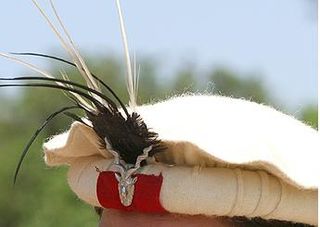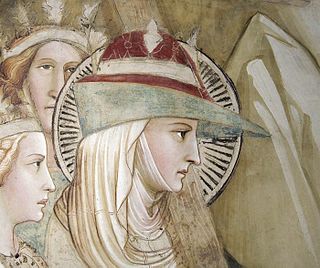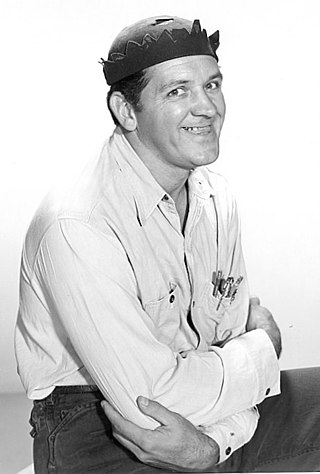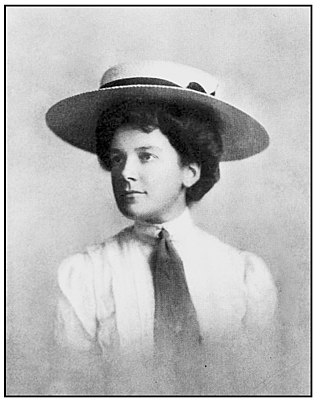Related Research Articles

A balaclava, also known as a balaclava helmet, ski mask or shiesty, is a form of cloth headgear designed to expose only part of the face, usually the eyes and mouth. Depending on style and how it is worn, only the eyes, mouth and nose, or just the front of the face are unprotected. Versions with enough of a full face opening may be rolled into a hat to cover the crown of the head or folded down as a collar around the neck.

The fez, also called tarboosh/tarboush, is a felt headdress in the shape of a short, cylindrical, truncated (peakless) hat, usually red, typically with a black tassel attached to the top. The name "fez" refers to the Moroccan city of Fez, where the dye to color the hat was extracted from crimson berries. However, its origins are disputed.
A knit cap is a piece of knitted headwear designed to provide warmth in cold weather. It usually has a simple tapered shape, although more elaborate variants exist. Historically made of wool, it is now often made of synthetic fibers.
A cap is a flat headgear, usually with a visor. Caps have crowns that fit very close to the head. They made their first appearance as early as 3200 BC. The origin of the word "cap" comes from the Old French word "chapeau" which means "head covering". Over time, the word has evolved and changed its meaning, but it still retains its association with headwear. Caps typically have a visor, or no brim at all. They are popular in casual and informal settings, and are seen in sports and fashion. They are typically designed for warmth, and often incorporate a visor to block sunlight from the eyes. They come in many shapes, sizes, and are of different brands. Baseball caps are one of the most common types of cap.

A hat is a head covering which is worn for various reasons, including protection against weather conditions, ceremonial reasons such as university graduation, religious reasons, safety, or as a fashion accessory. Hats which incorporate mechanical features, such as visors, spikes, flaps, braces or beer holders shade into the broader category of headgear.

A slouch hat is a wide-brimmed felt or cloth hat most commonly worn as part of a military uniform, often, although not always, with a chinstrap. It has been worn by military personnel from many different nations including Australia, Ireland, the United Kingdom, Canada, India, New Zealand, Southern Rhodesia, France, the United States, the Confederate States, Germany and many others. Australia and New Zealand have had various models of slouch hat as standard issue headwear since the late Victorian period.

Bonnet has been used as the name for a wide variety of headgear for both sexes—more often female—from the Middle Ages to the present. As with "hat" and "cap", it is impossible to generalize as to the styles for which the word has been used, but there is for both sexes a tendency to use the word for styles in soft material and lacking a brim, or at least one all the way round, rather than just at the front. Yet the term has also been used, for example, for steel helmets. This was from Scotland, where the term has long been especially popular.

A hood is a type of headgear or headwear that covers most of the head and neck, and sometimes the face. Hoods that cover mainly the sides and top of the head, and leave the face mostly or partly open may be worn for protection from the environment, for fashion, as a form of traditional dress or uniform, or in the case of knights, an armoured hood is used for protection against bladed weapons. In some cases, hoods are used to prevent the wearer from seeing where they are going. Hoods with eye holes may be used for religious purposes to prevent the wearer from being seen. In the case of Ku Klux Klan members, terrorists, or criminals such as robbers, a hood with eye holes helps prevent identification.

The Qing official headwear or Qingdai guanmao, also referred as the Official hats of the Qing dynasty or Mandarin hat in English, is a generic term which refers to the types of guanmao, a headgear, worn by the officials of the Qing dynasty in China. The Qing official headwear typically forms of part of the qizhuang system as opposed to the hanfu system and were completely different from the types of guanmao used in the previous dynasties. There were various forms of the Qing official headwear, and some were designed to be worn based on the winter or summer seasons; while others used varieties of decorations and adornment, such as the use of peacock feathers which could vary between one and three peacock eyes; these peacock feathers were bestowed by the Emperor to his officials who had accomplished meritorious services and the greatest number of peacock eyes represents the highest honour bestowed.

A petasos or petasus (Latin) is a broad brimmed hat of Thessalian origin worn by ancient Greeks, Thracians and Etruscans, often in combination with the chlamys cape. It was made of wool felt, leather, straw or animal skin. Women's versions had a high crown while those for men featured a lower crown. It was worn primarily by farmers, travellers and hunters, and was considered characteristic of rural people. As a winged hat, it became the symbol of Hermes, the Greek mythological messenger god.

The pith helmet, also known as the safari helmet, salacot, sola topee, sun helmet, topee, and topi is a lightweight cloth-covered helmet made of sholapith. The pith helmet originates from the Spanish military adaptation of the native salakot headgear of the Philippines.

A budenovka is a distinctive type of hat, an archetypal part of the Communist military uniforms of the Russian Civil War following the Russian revolution (1917–1922) and later conflicts. Its official name was the "broadcloth helmet". Named after Red Army cavalry commander Semyon Budyonny, it was also known as the "frunzenka" after the Commissar Mikhail Frunze. It is a soft, woolen hat that covers the ears and neck. The cap features a peak and folded earflaps that can be buttoned under the chin.

The pakol or pakul is a soft, flat, rolled-up, round-topped men's cap, usually worn in Afghanistan and Pakistan. It is typically made of wool and found in a variety of earthy colours, such as brown, black, grey, ivory, or dyed red using walnut. The pakol is believed to have originated in Chitral, or Gilgit-Baltistan in Pakistan.

A bycocket or bycoket is a style of hat that was fashionable for both men and women in Western Europe from the 13th to the 16th century. It has a wide brim that is turned up in the back and pointed in the front like a bird's beak. In French, it is called a chapeau à bec due to this resemblance.

A whoopee cap is a style of headwear popular among youths in the mid-20th century in the United States. It was often made from a man's felt fedora hat with the brim trimmed with a scalloped cut and turned up. In the 1920s and 1930s, such caps usually indicated the wearer was a mechanic. The headwear can often be seen worn in the films of the Dead End Kids. It is also referred to as a Jughead hat, palookaville cap, devils cap, clubhouse hat, dink cap, rat cap, or Kingpin.

A caul is a historical headress worn by women that covers tied-up hair. A fancy caul could be made of satin, velvet, fine silk or brocade, although a simple caul would commonly be made of white linen or cotton. The caul could be covered by a crespine or a hairnet to secure it from falling off.

Headgear, headwear, or headdress is any element of clothing which is worn on one's head, including hats, helmets, turbans and many other types. Headgear is worn for many purposes, including protection against the elements, decoration, or for religious or cultural reasons, including social conventions.

A sailor hat is a brimmed straw hat similar to those historically worn by nineteenth century sailors before the sailor cap became standard. It is very close in appearance to the masculine boater, although "sailors" as worn by women and children have their own distinct design, typically flat-crowned, wide-brimmed and with a dark ribbon band extending into streamers hanging off the brim. Such hats could also be made in felt as an alternative to straw.

A leather flying helmet, also known as an aviator hat or bomber hat, is a usually leather cap with large earflaps, a chin strap, and often a short bill that is commonly turned up at the front to show the lining. It is often worn with goggles. It may be made of other materials, such as felt.
References
- ↑ Amphlett, Hilda. Hats: A History of Fashion in Headwear.
- ↑ Hilda Amphlett (2003). Hats: A History of Fashion in Headwear. Courier Corporation. pp. 39–. ISBN 978-0-486-42746-1.
